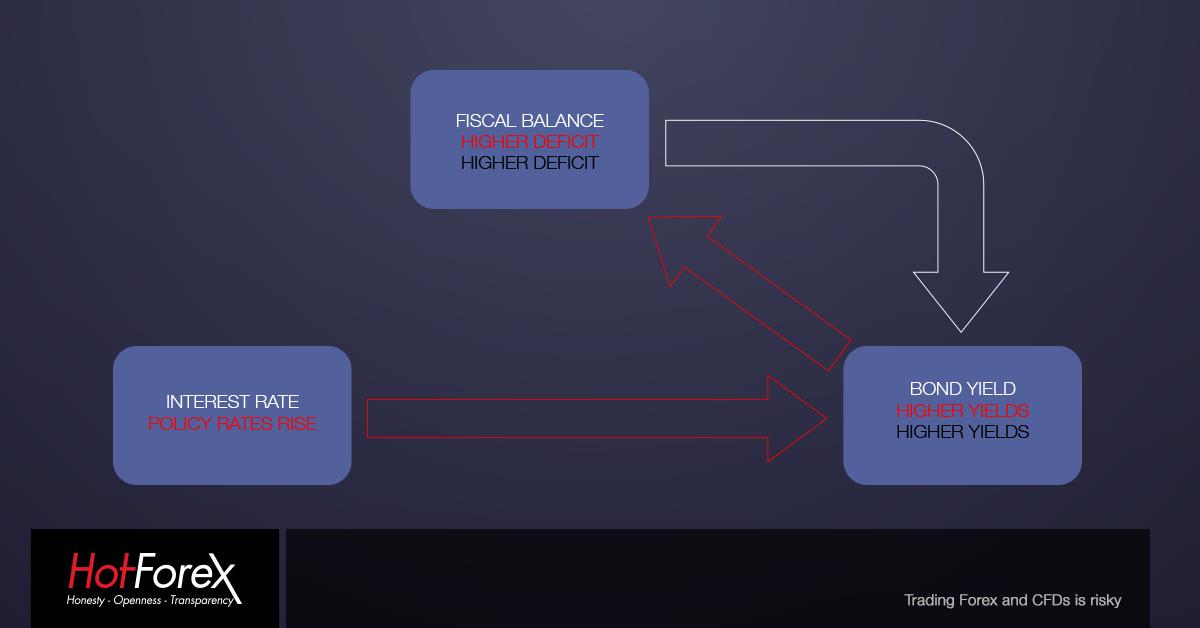The US fiscal deficit for the fiscal year 2018 was just reported to have increased to $779 billion, or approximately 4% of GDP for the period. As Reuters notes, the deficit has been the largest reported since 2012, during a time when elections were coming up and the economy was still at a low interest rate environment and perhaps also in need for more government spending. It is known that bond traders keep a close eye on fiscal and monetary developments. In the latest post on Fiscal Policy, I have commented how interest rates affect government finances but I have left one important piece out of the equation: how Fiscal Deficits themselves affect bond yields.
Overall, recall that higher interest rates, or even expectations of higher interest rates, cause bond yields to rise, given that investors demand higher compensation for their money as interest rates increase. This leads to raising the cost of borrowing for the government, which in turn leads to higher deficits, all else equal. Naturally, it could most likely be the case that interest rates have increased because of improved economic conditions and hence more taxes will be flowing in to cover for the raise in the bond yield.
Another important point is that fiscal deficits tend to also increase bond yields simply because there is more debt running for the same amount of investor funds. As such, investors can potentially gain higher compensation as demand for their funds has increased. Furthermore, the higher the deficit, the more unlikely it is that the state will remain able to meet its repayments. Consequently, higher, persistent deficits are indicative of higher risk in the economy as potential fiscal actions would need to be taken in the future, i.e. increases in taxation or spending cuts. This surge in non-payment risk is bound to increase yields as well.
In the case of the US, the current situation is indicative of both happening at the same time: the government keeps maintaining a large fiscal deficit and the Federal Reserve is on a bout of interest rate increases which should not end soon. The policy-important question is what happens to the economy when the government is forced to slash spending or increase taxation in order to maintain a sustainable fiscal position. As studies have shown, drops in spending can result to approximately one-for-one reductions in the GDP growth rate, although this effect is mostly observed in periods of recession. Still, in the US case, even a 0.5% drop in GDP growth for a 1% reduction in government spending could have important effects on its growth potentials, especially if it also constraints fiscal space during a recession. The US bond yield has been reflecting these developments as its price has been declining, which suggests that the bond yield is increasing. In fact, the combination of the two effects has sent the yield at more than 3% in September, for the first time since 2011.
Disclaimer: Nothing in this communication contains, or should be considered as containing, an investment advice or an investment recommendation or a solicitation for the purpose of purchase or sale of any financial instrument.
Recommended Content
Editors’ Picks
EUR/USD edges lower toward 1.0700 post-US PCE

EUR/USD stays under modest bearish pressure but manages to hold above 1.0700 in the American session on Friday. The US Dollar (USD) gathers strength against its rivals after the stronger-than-forecast PCE inflation data, not allowing the pair to gain traction.
GBP/USD retreats to 1.2500 on renewed USD strength

GBP/USD lost its traction and turned negative on the day near 1.2500. Following the stronger-than-expected PCE inflation readings from the US, the USD stays resilient and makes it difficult for the pair to gather recovery momentum.
Gold struggles to hold above $2,350 following US inflation

Gold turned south and declined toward $2,340, erasing a large portion of its daily gains, as the USD benefited from PCE inflation data. The benchmark 10-year US yield, however, stays in negative territory and helps XAU/USD limit its losses.
Bitcoin Weekly Forecast: BTC’s next breakout could propel it to $80,000 Premium

Bitcoin’s recent price consolidation could be nearing its end as technical indicators and on-chain metrics suggest a potential upward breakout. However, this move would not be straightforward and could punish impatient investors.
Week ahead – Hawkish risk as Fed and NFP on tap, Eurozone data eyed too

Fed meets on Wednesday as US inflation stays elevated. Will Friday’s jobs report bring relief or more angst for the markets? Eurozone flash GDP and CPI numbers in focus for the Euro.

